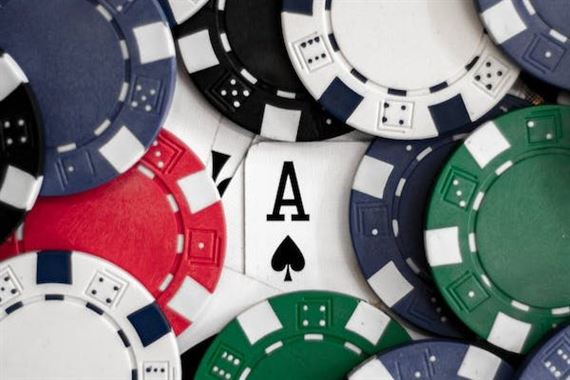The Mathematics of Poker: An Introduction is a book written by Bill Chen and Jerrod Ankenman. It is a comprehensive guide to the mathematical principles behind the game of poker. The book covers a wide range of topics, including probability, game theory, and decision-making strategies. It is a valuable resource for both novice and experienced poker players looking to improve their game.
The Importance of Probability in the Mathematics of Poker
Poker is a game of skill, strategy, and luck. It is a game that has been played for centuries, and it has evolved over time. Today, poker is played in casinos, online, and in homes all over the world. The game has become so popular that it has even been recognized as a sport. However, what many people do not realize is that poker is also a game of mathematics.
The mathematics of poker is a complex subject that involves probability, statistics, and game theory. In this article, we will focus on the importance of probability in the mathematics of poker.
Probability is the branch of mathematics that deals with the likelihood of an event occurring. In poker, probability is used to determine the odds of a particular hand winning. For example, if you have a pair of aces, what are the chances that another player has a better hand? The answer to this question lies in probability.
To understand probability in poker, you need to understand the concept of outs. Outs are the cards that can improve your hand. For example, if you have a flush draw, there are nine cards left in the deck that can complete your flush. These nine cards are your outs.
Once you know your outs, you can use probability to determine your chances of hitting your hand. The formula for calculating your chances of hitting your hand is simple. You take the number of outs you have and multiply it by two. The result is the percentage of the time you will hit your hand on the next card.
For example, if you have a flush draw with nine outs, your chances of hitting your hand on the next card are 18%. This means that you will hit your hand approximately one out of every five times.
Probability is also used to determine the odds of winning a hand. To calculate the odds of winning a hand, you need to know the number of outs you have and the number of cards left in the deck. The formula for calculating the odds of winning a hand is as follows:
(Number of outs / Number of cards left in the deck) x 100 = Odds of winning the hand
For example, if you have a flush draw with nine outs and there are 47 cards left in the deck, your odds of winning the hand are approximately 19%.
Probability is not the only mathematical concept used in poker. Statistics and game theory are also important. Statistics is used to analyze data and make informed decisions. In poker, statistics can be used to analyze your opponents’ playing styles and tendencies.
Game theory is the study of strategic decision-making. In poker, game theory is used to determine the optimal strategy for a particular situation. For example, if you have a strong hand, should you bet or check? The answer to this question depends on the situation and the players involved.
In conclusion, the mathematics of poker is a complex subject that involves probability, statistics, and game theory. Probability is the branch of mathematics that deals with the likelihood of an event occurring. In poker, probability is used to determine the odds of a particular hand winning. Understanding probability is essential to becoming a successful poker player. However, it is not the only mathematical concept used in poker. Statistics and game theory are also important. By understanding these concepts, you can improve your game and increase your chances of winning.
Understanding Expected Value in Poker Mathematics
Expected value is a concept that is used in many different areas of mathematics, including poker. In poker, expected value is the amount of money that a player can expect to win or lose on average over a long period of time. It is a way of measuring the profitability of a particular play or decision.
To understand expected value in poker, let’s consider a simple example. Imagine that you are playing a game of Texas Hold’em, and you are dealt a pair of aces. You decide to raise the bet, and your opponent calls. The flop comes out, and it is 2-7-10, with two clubs. You have no clubs in your hand, but you still have a pair of aces. You decide to bet again, and your opponent calls.
The turn card is a 6 of clubs, and you decide to check. Your opponent bets, and you decide to call. The river card is a 9 of diamonds, and you decide to check again. Your opponent bets, and you decide to call. Your opponent shows a flush, and you lose the hand.
Now, let’s calculate the expected value of this hand. To do this, we need to consider the probability of winning the hand and the amount of money that we can expect to win or lose. In this case, the probability of winning the hand was very low, since our opponent had a flush. However, we still had a pair of aces, which is a strong hand.
If we had won the hand, we would have won a total of $100, since that was the size of the pot. However, since we lost the hand, we lost $100. Therefore, the expected value of this hand was zero, since we neither won nor lost any money on average.
Now, let’s consider another example. Imagine that you are playing a game of Omaha, and you are dealt four cards of the same suit. You decide to raise the bet, and your opponent calls. The flop comes out, and it is 3-8-J, with two cards of your suit. You have a flush draw, which is a strong hand. You decide to bet again, and your opponent calls.
The turn card is a 10 of your suit, and you decide to bet again. Your opponent calls. The river card is a 7 of your suit, and you decide to bet again. Your opponent folds, and you win the pot.
Now, let’s calculate the expected value of this hand. To do this, we need to consider the probability of winning the hand and the amount of money that we can expect to win or lose. In this case, the probability of winning the hand was high, since we had a flush draw. We also had a strong hand, since we had four cards of the same suit.
If we had lost the hand, we would have lost the amount of money that we had bet. However, since we won the hand, we won a total of $100. Therefore, the expected value of this hand was positive, since we won money on average.
In conclusion, understanding expected value is an important part of the mathematics of poker. It is a way of measuring the profitability of a particular play or decision. By calculating the expected value of different hands and decisions, players can make more informed decisions and improve their overall performance at the table.
The Role of Game Theory in Poker Mathematics
Poker is a game of skill, strategy, and mathematics. While many players may rely on their instincts and gut feelings, the most successful players understand the underlying mathematics of the game. In particular, game theory plays a crucial role in poker mathematics.
Game theory is the study of decision-making in situations where multiple players have conflicting interests. In poker, each player is trying to win the pot, which means they must make decisions based on what they think their opponents are likely to do. Game theory provides a framework for analyzing these decisions and determining the optimal strategy.
One of the key concepts in game theory is the Nash equilibrium. This is a situation where no player can improve their outcome by changing their strategy, assuming that all other players are also playing optimally. In poker, the Nash equilibrium can be used to determine the optimal strategy for each player in a given situation.
For example, consider a simple game of heads-up no-limit Texas hold’em. Suppose the small blind has a pair of aces and raises, and the big blind has a pair of kings. The big blind must decide whether to call or re-raise. If they call, they risk losing the pot if the small blind has a better hand. If they re-raise, they risk losing even more if the small blind has a stronger hand or folds.
Using game theory, we can determine the optimal strategy for the big blind in this situation. If the small blind is playing optimally, they will raise with a wide range of hands, including some weaker hands that the big blind can beat. Therefore, the big blind should call with their kings, as this will result in the highest expected value over the long run.
Of course, in practice, players may not always play optimally. They may make mistakes or adjust their strategy based on their opponents’ tendencies. However, understanding the Nash equilibrium can still be useful for making informed decisions.
Another important concept in game theory is the concept of bluffing. Bluffing is when a player bets or raises with a weak hand in order to make their opponents fold stronger hands. Bluffing can be a powerful tool in poker, but it also involves a significant amount of risk.
Using game theory, we can analyze the optimal frequency of bluffing in a given situation. For example, suppose a player is heads-up on the river with a weak hand and decides to bluff. If they bluff too often, their opponent will catch on and call them more frequently, resulting in a net loss. On the other hand, if they never bluff, their opponent will always call them when they have a strong hand, resulting in a net loss as well.
Therefore, the optimal frequency of bluffing depends on the opponent’s strategy. If the opponent is likely to call with a wide range of hands, the player should bluff less often. If the opponent is likely to fold frequently, the player should bluff more often.
In conclusion, game theory plays a crucial role in poker mathematics. By understanding the Nash equilibrium and the optimal frequency of bluffing, players can make informed decisions and maximize their expected value. Of course, poker is a complex game with many variables, and no strategy is foolproof. However, by incorporating game theory into their decision-making process, players can gain a significant edge over their opponents.
The Mathematics Behind Bluffing in Poker
Bluffing is a risky move in poker. It can either win you the pot or cost you a lot of money. The key to successful bluffing is to understand the odds and probabilities of the game. You need to know when to bluff and when to fold. This requires a deep understanding of the mathematics behind the game.
The first thing you need to understand is the concept of pot odds. Pot odds are the ratio of the size of the pot to the size of the bet. For example, if the pot is $100 and the bet is $10, the pot odds are 10:1. Pot odds are important because they help you determine whether or not to call a bet. If the pot odds are in your favor, you should call the bet. If they are not, you should fold.
The next thing you need to understand is the concept of implied odds. Implied odds are the amount of money you can expect to win if you hit your hand. For example, if you have a flush draw and there is $100 in the pot, your implied odds are greater than if there was only $10 in the pot. Implied odds are important because they help you determine whether or not to call a bet even if the pot odds are not in your favor.
Another important concept in bluffing is the idea of expected value. Expected value is the amount of money you can expect to win or lose on average over the long run. For example, if you have a 50% chance of winning $100 and a 50% chance of losing $50, your expected value is $25. Expected value is important because it helps you determine whether or not a particular move is profitable in the long run.
The final concept you need to understand is the idea of range. Range is the set of hands that your opponent could have based on their actions. For example, if your opponent raises pre-flop, their range could include pocket aces, kings, queens, jacks, and so on. Understanding your opponent’s range is important because it helps you determine whether or not they are likely to have a strong hand.
Bluffing in poker is a complex and risky move. It requires a deep understanding of the mathematics behind the game. You need to understand pot odds, implied odds, expected value, and range. You also need to be able to read your opponents and understand their actions. Bluffing is not something that can be learned overnight. It takes time, practice, and experience to master. But with the right knowledge and skills, you can become a successful bluffer and win big at the poker table.
Using Statistics to Improve Your Poker Game
Statistics play a crucial role in poker. They help players make informed decisions about when to bet, call, or fold. By analyzing the probability of certain outcomes, players can make more accurate predictions about the likelihood of winning a hand. This, in turn, allows them to make more informed decisions about how to play their hand.
One of the most important statistics in poker is the odds of making a particular hand. For example, the odds of making a flush on the flop (the first three community cards) are approximately 1 in 118. Knowing this, a player can make a more informed decision about whether or not to continue playing their hand. If they have a hand that has the potential to make a flush, they may be more inclined to continue playing, whereas if they have a weak hand, they may be more likely to fold.
Another important statistic in poker is pot odds. Pot odds refer to the ratio of the size of the pot to the size of the bet. For example, if the pot is $100 and the bet is $10, the pot odds are 10:1. Knowing the pot odds can help a player determine whether or not it is worth it to call a bet. If the pot odds are favorable, meaning that the potential payout is greater than the amount of the bet, a player may be more inclined to call.
Expected value (EV) is another important statistic in poker. EV refers to the average amount of money a player can expect to win or lose on a particular hand. By calculating the EV of a hand, a player can make a more informed decision about whether or not to continue playing. If the EV is positive, meaning that the potential payout is greater than the amount of the bet, a player may be more inclined to continue playing. If the EV is negative, meaning that the potential payout is less than the amount of the bet, a player may be more likely to fold.
In addition to these statistics, there are many other factors that can influence a player’s decision-making in poker. These include the position at the table, the playing style of the other players, and the size of the blinds. By taking all of these factors into account, a player can make more informed decisions about how to play their hand.
In conclusion, statistics play a crucial role in poker. By analyzing the probability of certain outcomes, players can make more informed decisions about when to bet, call, or fold. Pot odds, expected value, and the odds of making a particular hand are just a few of the many statistics that can help a player improve their game. By mastering these statistics and taking all other factors into account, a player can become a more successful and profitable poker player.
Exploring the Mathematics of Hand Ranges in Poker
Hand ranges are a fundamental concept in poker. A hand range is the set of hands that a player could have based on their actions and the cards that have been revealed. Understanding hand ranges is essential because it allows players to make informed decisions about their own hands and their opponents’ hands.
To understand hand ranges, we must first understand the concept of probability. Probability is the likelihood of an event occurring. In poker, probability is used to determine the likelihood of a certain hand being dealt or a certain card being revealed.
For example, let’s say you are playing Texas Hold’em, and you are dealt two cards. The probability of being dealt a pair is approximately 5.9%. This means that out of every 100 hands, you can expect to be dealt a pair about six times.
Now, let’s say you are playing against an opponent, and they raise before the flop. Based on their actions, you can start to narrow down their hand range. For example, if they raise with a tight range, you can assume that they have a strong hand. If they raise with a wider range, you can assume that they have a weaker hand.
As the hand progresses, you can continue to narrow down your opponent’s hand range based on their actions and the cards that are revealed. For example, if they continue to bet aggressively, you can assume that they have a strong hand. If they check or call, you can assume that they have a weaker hand.
Understanding hand ranges is not just about narrowing down your opponent’s range. It is also about understanding your own hand range. For example, if you have a strong hand, you can bet aggressively to try to get your opponent to fold. If you have a weaker hand, you can check or call to try to see more cards and improve your hand.
In addition to understanding hand ranges, it is also important to understand pot odds. Pot odds are the ratio of the size of the pot to the size of the bet. Pot odds are used to determine whether or not it is profitable to call a bet.
For example, let’s say the pot is $100, and your opponent bets $20. The pot odds are 5:1 (100/20). This means that you need to win the hand at least 1 out of 5 times to break even. If you think you have a better than 1 in 5 chance of winning the hand, it is profitable to call the bet.
Understanding pot odds and hand ranges allows players to make informed decisions about their bets and their opponents’ bets. It allows players to calculate the expected value of their bets and make decisions that are profitable in the long run.
In conclusion, understanding the mathematics of hand ranges in poker is essential for any serious poker player. It allows players to make informed decisions about their own hands and their opponents’ hands. It allows players to calculate the expected value of their bets and make decisions that are profitable in the long run. By understanding hand ranges and pot odds, players can improve their overall strategy and increase their chances of winning at the poker table.
The Mathematics of Poker: An Introduction is a comprehensive guide to the mathematical principles behind the game of poker. It covers a wide range of topics, including probability, game theory, and decision-making strategies. The book is written in a clear and concise style, making it accessible to both novice and experienced players. Overall, it is a valuable resource for anyone looking to improve their understanding of the mathematics of poker.



